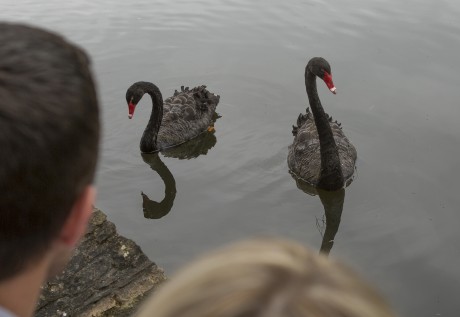
Two black swans similar to the pair that went missing
A THRIVING community group near Roslea which manages Killyfole Lake suffered a second set-back recently when ‘Jack’, the second of two black swans it bought for £500 last year, went missing.
Jack’s mate, ‘Jill’ disappeared last December. Both were firm favourites with visitors to Killyfole, particularly the children.
Jim Beattie, the chairman of Killyfole Development Association, believes both were stolen.
“The swans cannot fly and there was no sign of a kill by a fox or any other animal. I have chickens at home and, any time a mink or a fox comes about and takes one, there are always a few feathers lying about.”
He believes the bird, which are a protected species, have ended up on someone’s dinner table.
“We reported at the time to the police but they said it’s a wild animal that probably flew away, but we said not so because the tips of their wings are doctored to prevent them flying.”
Jim’s fears that the birds were stolen were enhanced when he spoke to the English supplier to ask about a replacement for ‘Jill’.
“He told us it was a big problem in the area, replacing black swans, that there was a problem with people stealing them.”
Evan at that, the Jim and his fellow members have been following up leads, including unconfirmed sighting of a black swan in the Ballybay Wetlands across the border in Co Monaghan.
“We went there a couple of times to check, but found nothing. It may have been one that migrated from somewhere.”
He is now hoping that, through the Herald and an appeal on the Annmarie McAleese Radio Ulster Saturday morning show someone, somewhere will provide information to the police or the Killyfole group.
At the moment, they have no plans to buy in replacements and, until they do so, ‘Jack’ and ‘Jill’ will be sorely missed among the birds and ducks on the lake that visitors stop off to admire, and feed.
“The two would not come right up to people to be fed by hand, but near enough to be grabbed”, he added.
Richard James, an RSPB wildlife adviser, said sightings of black swans have become reasonably common.
“They are native to Australia and, in fact, they are the state bird of Western Australia. They are similar in size to the closely related mute swan. They appear all black when swimming, but they have white primary wing feathers, which can be seen in flight. The bill is red with a broad white band on the tip.
There have been occasional reports of successful breeding attempts in the UK but they have not become established.”








